By Andrew Karp: Group Editor, Lenses and Technology
NEW YORK—Buying a pair of eyeglasses can be a complex, puzzling
and even frustrating experience for many consumers. The process is often
fraught with uncertainty, with consumers asking dispensers questions
such as “Do these glasses look good on me?” “Can you get them to fit me
more comfortably?” “Will these new lenses really help me see better?”
and “Am I getting my money’s worth?”
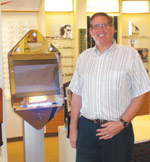 |
| Barry Santini of Long Island Opticians displays his ABS Smart Centration
Diamond system. |
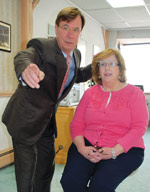
|
| Dispensing optician Ronald Riesz instructs a patient to look at the
camera in the Optikam Tech OptiCentration kiosk in his Arlington,
Mass. shop. |
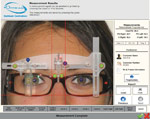
|
| Patient being measured by Optikam’s OptiCentration kiosk. |
Fortunately, a new generation of eyewear dispensing technology is
helping eyecare professionals allay their customers’ concerns by making
the dispensing process more precise, personal and ultimately, more
enjoyable.
The new technologies—offered by companies such as Carl Zeiss
Vision, Essilor, Optikam, ABS and Shamir Insight—range from cutting-edge
dispensing systems that take digital photographs and measurements to
simple hand tools. What they have in common is the ability to precisely
capture patient measurements, including how the frame fits the patient
and the position in which it is worn. Combining this biometric data with
the patient’s prescription and a digital lens design enables the
optical laboratory to produce one-of-a-kind lenses that optimizes the
performance of the lens and gives the wearer a totally personalized
viewing experience.
Along with the “wow” reaction these lenses typically elicit from
wearers, patients are often favorably impressed with the high tech look
and feel of the dispensing system itself and well as with useful
features such as taking digital photos of consumers trying on their new
eyewear and then emailing them the photos, or demonstrating premium lens
options.
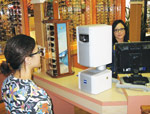 |
| An optician at the Phelan, Calif. office of Bryan Vanesian, OD (r) uses
the Zeiss iTerminal to measure a patient for Zeiss lenses. |
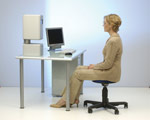
|
| Zeiss iTerminal. |
Interviews with several ECPs reveal that the new technologies are
boosting sales of premium lenses, reducing redos and creating a unique
patient experience that can’t be duplicated by an online, virtual
dispensary—at least not yet. One proponent is Barry Santini, an optician
and writer who owns Long Island Opticians in Seaford, N.Y. He believes
that taking eyewear measurements with digital photographs offers
distinct advantages over older technologies such as pupillometers.
“Precision is enhanced,” said Santini. “Most digital centration
devices deliver a precision of a tenth of a millimeter, which is more
precise by a factor of five than a common digital-readout pupillometer.
Accuracy is also enhanced.”
Another benefit is improved repeatability, according to Santini.
As he pointed out, “In many busy offices, there are multiple employees
of varying skill levels. Digital picture measurements reduce the
variations between operators as well as between successive measurements
by a single operator.”
In addition, taking digital photos and measurements allows the
dispenser to properly consider how the frame fit the patient, Santini
said.
“The advent of wrap around eyewear, as well as position of wear
enhanced single vision and progressive lenses, require that ECPs obtain
good values not only for PD and pupil height, but also for vertex
distance, pantoscopic tilt and panoramic (aka face-form) angle,” he
noted. “Taking these position-of-wear measurements can be daunting to
dispensary personal, primarily due to their unfamiliarity. Obtaining
these via digital pictures is easy and makes both the dispensary and lab
better partners in the visual performance delivered to the patient.”
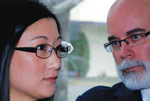 |
|
| Dispensing optician Jim Voss of the John Boys Smith Vision Center uses a
tool from the Shamir Panoramter kit to measure a patient’s vertex
distance. |
|
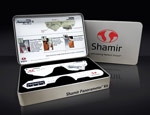
|
|
| Shamir Panorameter kit. |
|
Santini uses the ABS Smart Mirror’s Smart Centration Diamond
system at Long Island Opticians. He said the system’s eye catching
design attracts the attention of customers.
“In our office, we have placed our Smart Mirror in a prominent
position, directly between our two dispensing desks. In this placement,
every client asks us ‘What is that thing?’ We reply, ‘It is our new tool
for helping you view new frames styles, as well as helping us take the
best and most accurate measurements.’ Our customers are always
impressed, and we’ll quickly demonstrate how easy and intuitive it is to
operate. Children watch and listen, and then waste no time showing Mom
and Dad their natural facility in using the Smart Mirror. I often
comment that we’re grooming future opticians.”
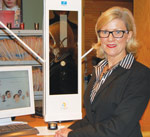 |
| Jean Sabre of the Uptown Vision Clinic in Minneapolis with the Essilor
Visioffice system. |
Ronald Riesz, whose eponymously named optical shop is located in
the Boston suburb of Arlington, Massachusetts, has also been won over by
the new fitting technologies. For the past year, Riesz has been using
the OptiCentration kiosk made by Optikam, a Montreal-based company. He
believes it is having a positive effect on his customers as well as on
his business.
“The measurements it takes are unbelievably accurate,” said
Riesz, who, like most opticians, was accustomed to measuring PDs with
either a pupillometer or with the time honored method of shining a
penlight in the patient’s eye, locating the center of their pupil and
dotting the lens with a felt-tipped marker.
“Before I started using OptiCentration, I didn’t have many
do-overs,” said Riesz. “But if I was off a little, even by a few
millimeters, I’d have to take the measurement again,” he said. “Now,
every time I take measurements, I have no redos. The height and the PD
are precise, and there’s less distortion on the side. It’s scary.”
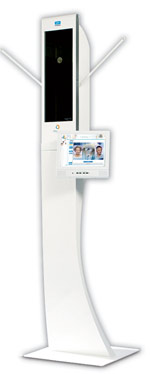 |
|
| Essilor’s new Visioffice tower. |
|
Even though it takes a few minutes longer to measure a patient
with OptiCentration, Riesz uses it on all types of customers, including
both progressive and single vision lens wearers. He said it is
particularly useful for measuring patients with strong prescriptions,
and pointed out that the stronger the prescription, the more accurate
the optical center has to be.
“If the optical center is off, your eyes get tired and you can’t
read for a long time. If you have a strong reading prescription, you
want everything in center of the eye.”
Although he could occasionally still uses a pupillometer for
measuring PD, Riesz prefers OptiCentration for its versatility,
especially its ability to demonstrate premium lenses.
“You’ve can demonstrate AR lenses and show the patient how things
would look like at night, in the rain or driving,” he pointed out. “If
you can sell a pair of Essilor Avancé [AR lenses] you’ve got a little
profit. You can also demonstrate Transitions lenses indoors or outdoors,
or show them the thinness of a high-index.”
Another plus using the Optikam system is that it impresses
patients, especially when they see other patients being measured, Riesz
said. “Patients who see me use it say “Why don’t you use that machine on
me?”
Riesz said that although he was initially nervous about the
system’s $8,000 price tag, he believes the investment is well
worthwhile. “A four-year lease is only about $240 a month,” he noted,
which is less than the price he charges for a pair of premium
progressives.
Optometrist Bryan Vanesian has also recently embraced new
dispensing technology. About six months ago, he acquired a Carl Zeiss
Vision iTerminal for his office in rural Phelan, Calif., which is about a
two-hour drive west of Los Angeles. Dr. Vanesian said he got the
iTerminal for two main reasons. “I like high-tech stuff, and I wanted to
lower the number of doctor redos because the progressives weren’t
measured correctly by my staff.”
According to Dr. Vanesian, the iTerminal hasn’t completely
eliminated redos because some patients still raise or lower their head
when their photo is taken, which can throw off the measurements. But he
said the system has lowered redo rates, primarily because of its
precision. “It measures up to a tenth of a millimeter, and up to a tenth
of a degree of rotation,” he noted.
“One of the things about having iTerminal is that it gives us
access to true custom made lenses like Zeiss Individual, which you can’t
even prescribe unless you have an iTerminal,” Dr. Vanesian said. When
describing the benefits of the Zeiss Individual, he makes sure to tell
patients that “These aren’t your regular progressives that you’d get
from a mass merchant. We can custom make your lens, with your initials
engraved into it.”
Dr. Vanesian also likes the iTerminal because it “goes with the
flow” of his office. “We’re paperless, we have the Zeiss GDx machine for
glaucoma diagnosis, and we have the Optos retinal scan, the new 3D
model,” he said. “Now we can take our high tech approach into the
optical, rather than just using rulers and felt markers for measuring
and marking lenses. Visually, the unit is very appealing. It’s two white
blocks. It’s almost like Apple made it.”
Dr. Vanesian said his staff uses the iTerminal mostly with higher
prescriptions in order to give them the widest field view and lowest
distortion. Like Ronald Riesz, he uses it not just for progressives, but
for single vision lenses as well such as the single vision version of
the Zeiss Individual which features free form front and back surfaces.
“iTerminal has helped us sell more premium eyewear such as the
Zeiss Individual progressive, which we charge $610 for, or the Zeiss
Individual single vision, which sells for $450,” said Dr. Vanesian.
“That brings the total cost of the eyewear close to $1,000. It amazes me
that my staff doesn’t have too have much trouble selling them, because
this is a blue collar town.”
Dr. Vanesian cited another benefit of the iTerminal. “We have
patients who have worn PALs and could not adapt to progressives before
but are now able to wear these lenses,” he said. “So there’s got to be
something to it. There’s less distortion and wider intermediate zones.
We have a very low redo rate. We’ve only had two non-adapts in six
months.”
As with many types of high tech equipment, proper training is
required to operate the iTerminal and derive its full benefits. “When we
first got the machine, we were having lot of problems with redos,” said
Dr. Vanesian. “It turned out they didn’t teach us how to use the
machine. Once we were retrained, everything was fine. There is a
learning curve.”
He praised Zeiss for its responsiveness to his start-up problems.
“The rep would come and bring lunch, go over all of the problems and
questions we had, then retrain the staff and train new employees. It’s
important to have staff that feels comfortable selling $600 lenses. You
don’t want a machine like this sitting in the corner.”
Dr. Vanesian said the iTerminal is quickly proving its value. “In
order to cover the cost of the machine, which is about $7,500, Zeiss
wants us to sell about 180 pairs of lenses in 18 months, which is about
10 pairs a month. We’ve easily met that number. It’s a sweet deal.”
As dispensing systems evolve, developers are adding new
capabilities to them. The latest system to hit the market is Visioffice,
which Essilor has just released in the U.S. In addition to measuring
wrap angle, pantoscopic tilt, vertex distance, monocular PD, fitting
height and A, B, DBL values, Visioffice measures optical eye rotation
center for each eye and natural head posture for proprietary “eyecode”
lenses, which are available on select Varilux and Essilor single vision
lenses. Visioffice also measures the stability ratio and head/eye
coefficient that are needed to dispense Varilux Ipseo IV lenses.
Optician Jean Sabre, who, with her husband, Mark Sabre, OD,
co-owns Uptown Vision Clinic in Minneapolis, has been using a Visioffice
prototype for over a year, and credits it for helping to sell more
premium lenses. “Visioffice has had a huge impact on our practice,” she
said. “We primarily use it for progressives, especially the new digital
lenses such as Varilux Ipseo. It gives us a higher level of accuracy.”
Sabre added that Visioffice also helps patients select frames.
“We’re able to image four different frames for a patient to view, so
they can see the frames side by side,” she said. “The system also has
email capabilities, in case the patient wants someone to get input on
their choices. We’ve even had patients put photos on Facebook so people
can vote on which frame they like best. We can also print out a photo
like in a photo booth so the patient can take it with them.”
Although digital dispensing has an undeniable “wow” factor with
patients, some ECPs said a low tech approach can also be effective. Jim
Voss, a dispensing optician at the John Boys Smith Vision Center in
Ellensburg, Wash., relies on the Shamir Panorameter kit for measuring
patients. The kit contains two simple, plastic hand-held tools. One tool
measures panoramic angle and pantoscopic tilt; the other measures
vertex distance.
“These tools give us the ability to accurately measure
pantoscopic tilt and frame wrap,” detailed Voss. “In the old days, you’d
have the patient turn their head and you’d say, ‘That’s pretty close to
10 degrees.’ Now the precision is increased exponentially. The tools
are simple and elegant. You don’t need all the electronics to use them,”
he said.
According to Voss, using the Panorameter has significantly
reduced the number of redos at the vision center. “We’ve had a much
higher rate of patient satisfaction, too,” he said. “When people put the
lenses on they are amazed. We’ve had very few problems with Shamir
Autograph lenses, very few rejections.
“It’s really increased my ability to do a better job,” Voss
concluded. “I can give the lab everything it needs, including an
accurate prescription and frame parameters.”
Whether dispensers take a high tech or low tech approach to
fitting eyewear doesn’t seem to matter, as long as it reduces the number
of redos. As Jean Sabre of the Uptown Vision Clinic remarked, “The more
accurate your measurements are, the more success you’ll have in fitting
lenses. We have less redos and patients are happier. And if they’re
happy, we’re happy.”
■
■
akarp@jobson.com